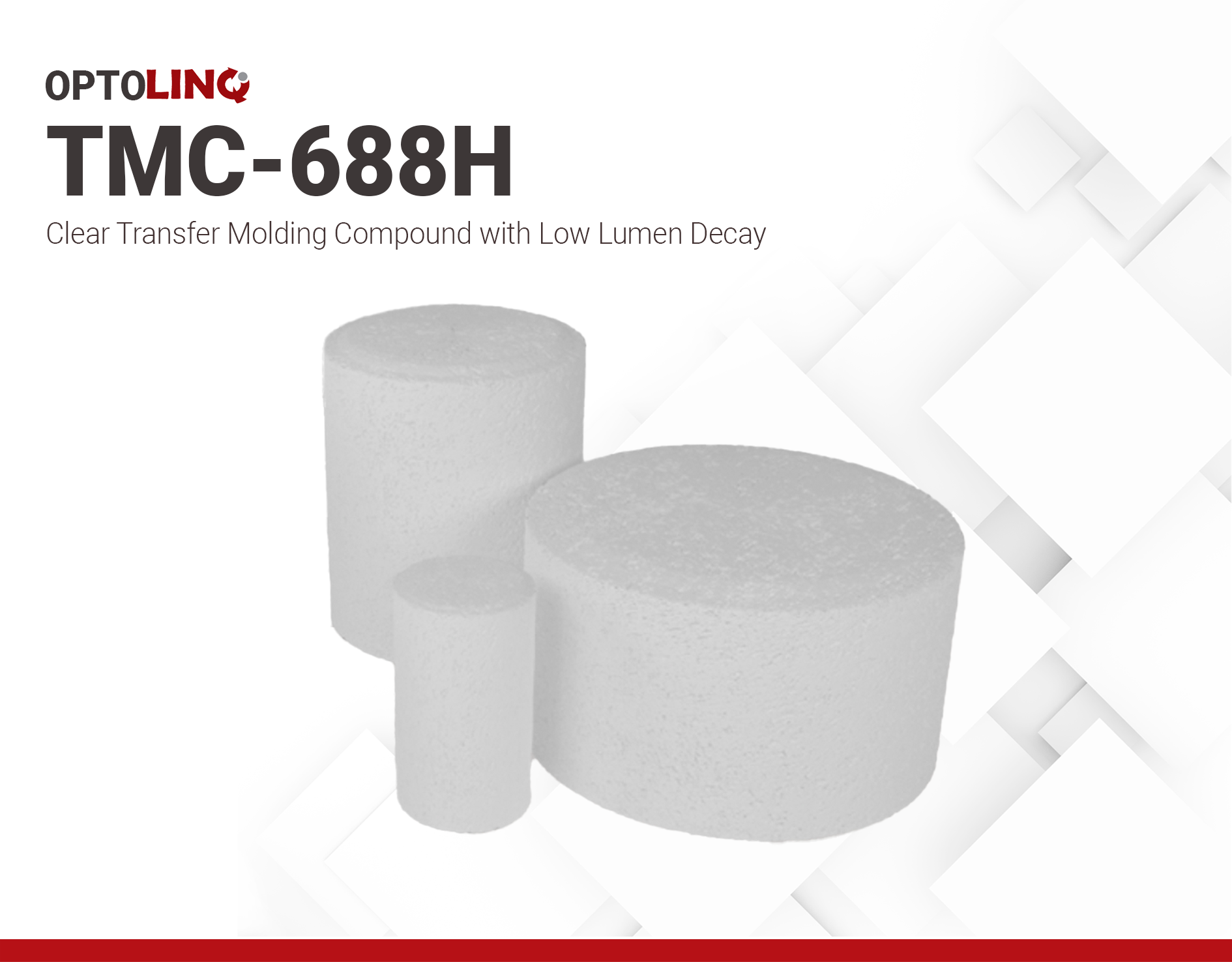OPTOLINQ TMC-688H | Transparent Mold Compound
- Low Lumen Decay
- High Glass Transition Temperature
- Superior moldability and reliability
Product Description
OPTOLINQ TMC-688H is an optically clear epoxy molding compound specifically designed for the encapsulation of applications that require low lumen decay and low stress molding. Its high glass transition temperature ensures good performance in high-temperature environments.
OPTOLINQ TMC-688H offers excellent moisture resistance, maintaining performance even in high temperature and humidity conditions. TMC-688H stands out with its superior moldability and reliability, ensuring good quality and precision in optoelectronic device molding.
A variant of TMC-688H is also available with a lower modulus associated with a reduced glass transition temperature.
OPTOLINQ TMC-688H comes in different sizes to meet various mold design requirements. Contact us for custom sizes or other specific requirements.
Key Features
- High IR Transparency: Ensures superior infrared light transmission for optimal device performance.
- Low Moisture Absorption & Excellent Moisture Resistance: Effectively prevents moisture ingress, safeguarding long-term reliability.
- Reliable Under Harsh Conditions: Maintains consistent performance in environments with elevated temperature and humidity.
- High Adhesion & Low Stress: Provides strong, durable bonding with minimal internal stress, reducing the risk of delamination or cracking.
Typical Applications
- LED indicative devices
- In/outdoor Display
- Backlight Source
- White light products
Versions Available
- Standard low modulus optical molding compound - TMC-688L
- High glass transition temperature - TMC-688H
Alternative to: XX-830 Series, XX-831 series
Technical Specifications
| General Properties | |||||||
| Specific Gravity Specific Gravity Specific gravity (SG) is the ratio of the density of a substance to the density of a reference substance; equivalently, it is the ratio of the mass of a substance to the mass of a reference substance for the same given volume. For liquids, the reference substance is almost always water (1), while for gases, it is air (1.18) at room temperature. Specific gravity is unitless. | 1.25 | ||||||
| Thermal Properties | |||||||
| Glass Transition Temperature (Tg) Glass Transition Temperature (Tg) The glass transition temperature for organic adhesives is a temperature region where the polymers change from glassy and brittle to soft and rubbery. Increasing the temperature further continues the softening process as the viscosity drops too. Temperatures between the glass transition temperature and below the decomposition point of the adhesive are the best region for bonding. The glass-transition temperature Tg of a material characterizes the range of temperatures over which this glass transition occurs. | >145 °C | ||||||
| |||||||
| |||||||
| Mechanical Properties | |||||||
| Molded Shrinkage | 1.5 % | ||||||
| |||||||
| |||||||
| Curing Conditions | |||||||
| Transfer Time | 75 ±25 s | ||||||
| |||||||
| Physical Properties | |||||||
| Spiral Flow @ 175°C | 170 ±70 cm | ||||||
Additional Information
OPTOLINQ TMC-688H Series Technical Specifications
| Property | Unit | TMC-688H | TMC-688L |
| Transmittance at 400 nm (1 mm) | % | >85 | >85 |
| Pellet Color | – | White | White |
| Specific gravity | – | 1.25–1.3 | 1.25–1.3 |
| Spiral flow at 150 °C | cm | 170 ± 70 | 170 ± 70 |
| Glass transition temperature (Tg) | °C | >145 | >115 |
| Coefficient of thermal expansion, α1 | ppm/°C | 60 ± 20 | 75 ± 25 |
| Coefficient of thermal expansion, α2 | ppm/°C | 180 ± 20 | 190 ± 20 |
| Gel time at 150 °C | s | 25–60 | 25–60 |
| Mold Shrinkage | % | <1.5 | <1.5 |
| Flexural strength | MPa | >120 | >120 |
| Flexural modulus | GPa | 3.55 ± 0.25 | 3.05 ± 0.15 |
Processing Instructions
- Before use, allow TMC-688H to reach room temperature (20±5 °C, 40±15% RH) for a minimum of 24 hours for larger pellets and 12 hours for smaller ones, ensuring the bag remains unopened to prevent moisture contamination.
- For TMC-688H in larger sizes, preheating can be performed using standard RF equipment. Preheating must be done slowly to achieve uniform temperature.
- Apply an outer releasing agent, such as silicones or fluorinated compounds, to the mold surface to facilitate easy release from the mold dies.
- Prior to molding with TMC-688H or any new material, the mold should be cleaned thoroughly. To prepare the mold, the initial three shots should be cured for 5–10 minutes. After this initial preparation period, you can reduce the curing time to a level that provides sufficient hot hardness for effective release.
Storage and Handling
OPTOLINQ TMC-688H is available in pressed pellets in a wide range of sizes to meet specific customer needs. To ensure product integrity, keep it away from oxidizing materials. For long-term storage, maintain a cold environment, ideally at –10°C or lower. The shelf life under this condition is 6 months.




